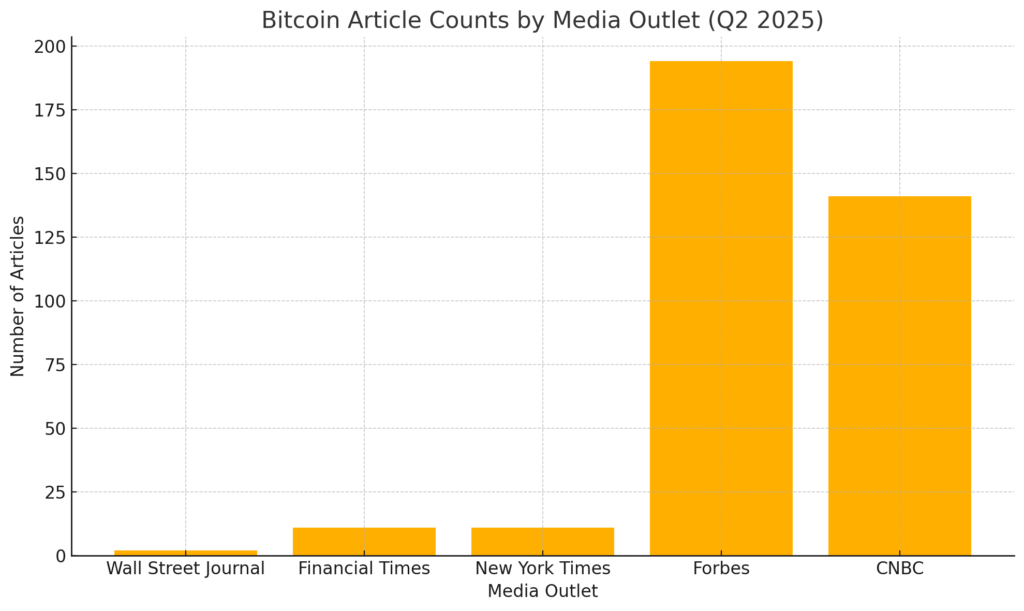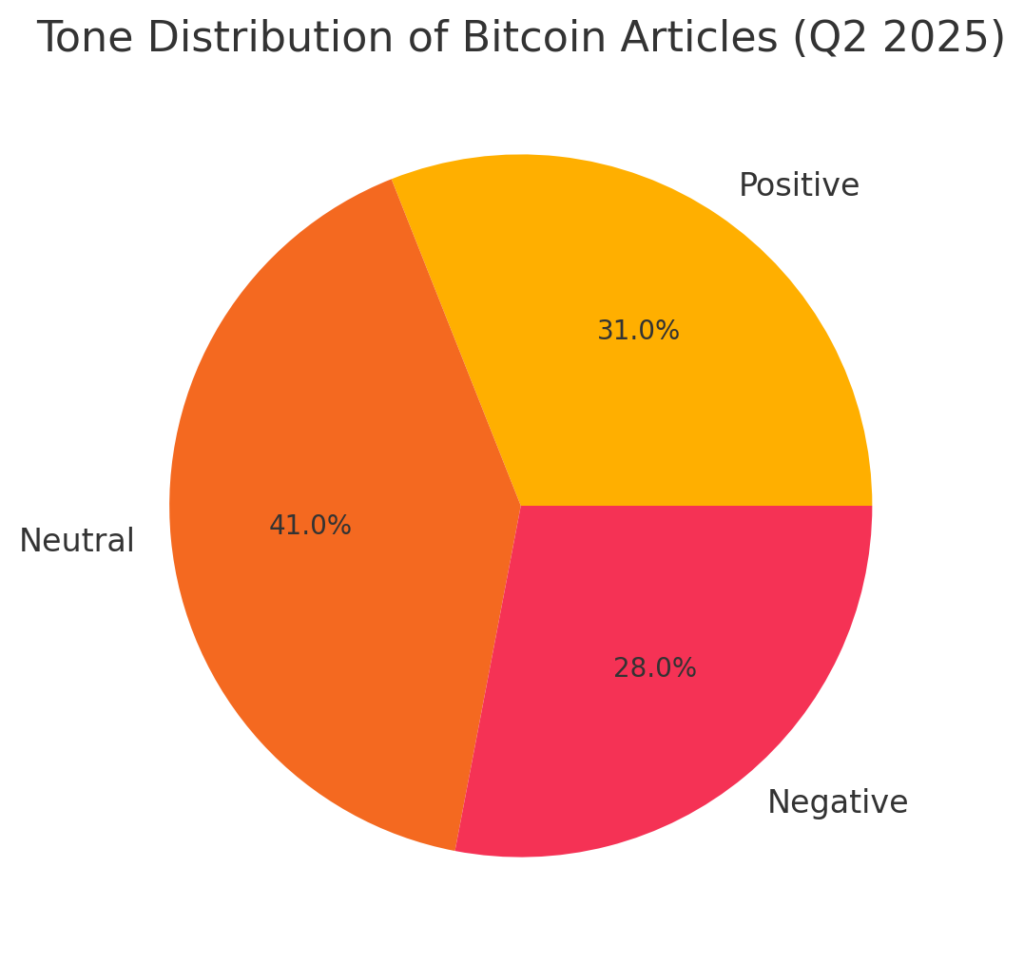
Main Points:
- Significant gap in Bitcoin coverage between mainstream general newspapers and specialized financial outlets
- Overall sentiment: 31% positive, 41% neutral, 28% negative
- Forbes (194 articles) and CNBC (141) lead in volume; WSJ (2), FT (11), NYT (11) lag behind
- Institutional adoption driving Bitcoin’s macro narrative and ETF inflows hitting ~$50 billion since January 2024
- Bitcoin surged ~30.9% in Q2 2025, bolstered by ETF demand and corporate treasury adoption
- Bitcoin ETFs have attracted ~$13.5 billion in inflows in 2025, rivaling 70% of gold ETF inflows
- Savvy investors can exploit coverage gaps by monitoring specialized outlets and ETF flow data
1. Growing Disparities in Media Coverage
In Q2 2025, Perception’s analysis of 1,116 Bitcoin-related articles across 18 major news outlets revealed a stark coverage disparity. Mainstream general newspapers—like the Wall Street Journal, Financial Times, and New York Times—published a combined 24 articles, while specialized business media such as Forbes and CNBC produced over 335 articles. This divergence, termed the “editorial blind spot,” suggests that many mainstream readers may be unaware of Bitcoin’s robust institutional integration and macro asset evolution.
2. Sentiment Analysis of Bitcoin Reporting
Overall, 31% of articles carried a positive tone toward Bitcoin, 41% were neutral, and 28% were negative. This balance indicates that, despite persistent skepticism in some quarters, a plurality of coverage maintains an even-handed assessment, with the greatest share remaining neutral. The sentiment breakdown suggests that neutral reporting predominates, potentially leaving readers without clear guidance on Bitcoin’s investment merits.
3. Traditional vs. Financial Media: A Coverage Gap

Bar chart: Bitcoin Article Counts by Media Outlet (see above)
As illustrated, Forbes led with 194 articles, over 17× the combined total of the Financial Times and New York Times, and nearly 100× the Wall Street Journal’s output. Financial media outlets focus on Bitcoin’s indicators of adoption—such as on-chain metrics, ETF launches, and corporate treasury allocations—portraying Bitcoin as a macro asset rather than a fleeting trend.
4. Bitcoin’s Institutional Backing and ETF Inflows
Since the U.S. spot Bitcoin ETFs debuted in January 2024, they have drawn approximately $50 billion in net inflows, with BlackRock’s iShares Bitcoin Trust (IBIT) alone holding roughly 700,000 BTC ($108,574 per BTC) and $76 billion in assets under management. In 2025 year-to-date, Bitcoin-focused ETFs have attracted $13.5 billion, equating to about 70% of gold ETF inflows, underscoring cryptocurrencies’ growing competition with traditional safe-haven assets.
5. Market Performance Anchored by ETF Activity

Bitcoin closed June 2025 at a record monthly high above $107,000, marking a 30.9% gain in Q2 2025, driven largely by institutional demand and favorable seasonal trends. This performance highlights how ETF flows, corporate adoption (over 135 public companies now hold Bitcoin as a reserve asset), and algorithmic trading strategies tied to macro data are collectively reinforcing Bitcoin’s market legitimacy.
6. Advantages for Savvy Investors
Investors who exclusively track general-interest outlets may overlook early signals of asset rotation into Bitcoin. By contrast, monitoring specialized financial media coverage, ETF inflow data, and corporate treasury movements offers actionable insights. Portfolio managers can use media sentiment as a contrarian indicator—shifting allocation toward Bitcoin when coverage is scant or overly negative and trimming positions when coverage peaks in positivity.
Conclusion
The reporting “dead zones” in mainstream newspaper coverage represent an investment edge for those seeking to capitalize on Bitcoin’s evolving role as a macro asset. With institutional flows surging—$50 billion since ETF inception and nearly $14 billion in 2025—and Bitcoin’s price up nearly 31% in Q2 2025, the narrative has shifted from speculative novelty to strategic portfolio diversification. By aligning media monitoring with on-chain analytics and ETF inflows, investors can navigate this developing landscape, seizing opportunities hidden in plain sight.

